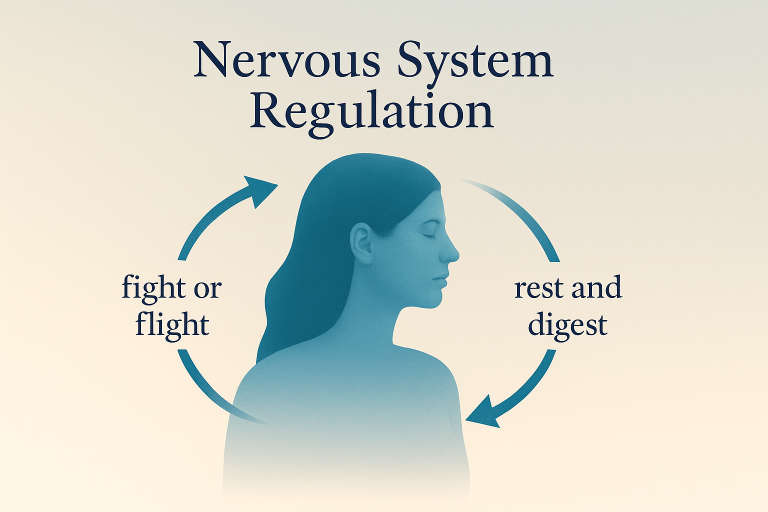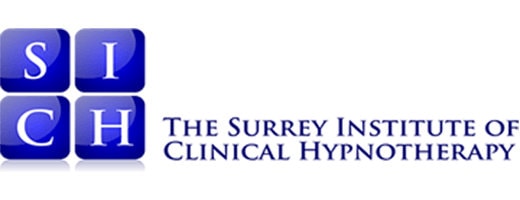Presentation nerves can arrive out of nowhere. You know your material, you have practised, and yet when you stand to speak your body surges, your mouth dries, thoughts scatter, and you feel cornered by a reaction you did not choose.
If this sounds familiar, you are not broken and you are not alone. At The Surrey Institute of Clinical Hypnotherapy we treat presentation nerves as a functional pattern that can be changed.
By working at the level of Functional Neurological Disorder, often shortened to FND, which in plain English means the brain has learned to predict threat and triggers a very real body response even when you are safe, and by building Nervous System Regulation, NSR, the learnable skills that steady breath, voice, and focus, you can reclaim a calm, natural way of speaking.

Table of Contents
- The Benefits of Removing Presentation Nerves
- Where FND and NSR fit in
- Why Presentation Nerves Become Sticky
- Our Approach to Presentation Nerves
- How Life Feels After The Change
- Who Presentation Nerves Work Helps
- Why Hypnotherapy Suits Presentation Nerves
- Fees And Practical Details
- Frequently Asked Questions for Presentation Nerves
- A Different Way to Picture Your Next Talk
- Your Next Step
What Presentation Nerves Really Are
Presentation nerves are not a character flaw. They are a learned prediction. Somewhere along the way your brain decided that being seen and heard equals risk. That prediction fires the survival reflex. Breathing rises, heart rate climbs, blood flow shifts, throat narrows, attention narrows to threat.
The body does not ask your permission, it simply reacts. This is a functional pattern, not a fixed condition, which is why targeted hypnotherapy and regulation work so well.
You might notice the classic signs of presentation nerves during meetings, pitches, interviews, or celebrations. A burst of heat through the face, a racing heartbeat, mental blanks, a voice that feels thin or unreliable, hands that fidget on their own.
The more you dread it, the quicker the loop starts.
Before you know it, you are building a life around avoiding situations that matter.
Common signs of presentation nerves include a racing heartbeat, sudden heat and sweating, blushing, scrambled thinking, stuttering or rushing, fidgeting, and a strong urge to escape.
The Benefits of Removing Presentation Nerves
Our specialists have helped many people within businesses and large corporations become confident and effective speakers, where they are able to deliver effective and engaging presentations that successfully deliver the message to their audience.
However, this issue is not just important to businesses. We have helped people to deliver effective presentations and speeches at weddings, PTA meetings, and even on the TV programme ‘Dragons Den‘, where the participant did so well that they became a dragon slayer by getting the backing. Peter Jones actually commented that our client was very confident.
Where FND and NSR fit in
In simple terms, these terms describe the mechanism and the fix.
Functional Neurological Disorder (FND)
In neurology this label describes symptoms driven by how the nervous system functions rather than by structural damage. In our context it means your system has learned to mislabel speaking as danger, which can create real sensations like a tight throat, heat, shaking, or mind blanks. We are not providing a medical diagnosis. We are addressing the functional response that keeps the alarm running.
Nervous System Regulation (NSR)
These are practical ways to help your autonomic nervous system shift from fight or flight into a balanced state.
Through hypnotherapy we install simple, automatic regulatory responses, breath and body resets, that your system can use automatically while you speak.
When you combine both, you update the prediction at the subconscious level and give the body reliable ways to hold steady while you speak. We then rehearse the exact moments that used to wobble until steadiness feels normal.

This is why a willpower approach rarely works. When the reflex is already firing, telling yourself to relax often makes things worse. You need the reflex to change first. Hypnotherapy lets us do that with precision. We work directly with the subconscious beliefs that drive presentation nerves, then pair the change with simple regulatory skills that the body can use automatically.
Why Presentation Nerves Become Sticky
Two ingredients tend to keep presentation nerves going. First, avoidance. Each time you avoid an opportunity, your brain learns the false lesson that avoidance kept you safe. Second, struggle. When you get caught in the surge and try to force your way through, your system tags the memory with high arousal. The next time you even think about speaking, the body prepares for trouble. The good news is that this stickiness is learned, which means it can be unlearned with the right process.
Our Approach to Presentation Nerves
Since 2003 our anxiety specialists have helped thousands of clients change the way they respond to being seen and heard. We treat presentation nerves with a combined FND and NSR approach that is brief, humane, and practical. Most clients complete their programme in three or four sessions, sometimes with an extra fine tune before a big event.
Recode The Trigger at Source
We begin by finding where the spike actually starts. For some it is hearing their name, for others eye contact, the first sentence, or a key slide. In focused trance we soften the old association and install a new prediction, safe to speak, safe to pause, safe to be seen. This is the FND piece in action, changing the functional programme that used to pull the alarm.
Train Automatic Regulation
Next we build NSR into your delivery. You will learn a few small behaviours that calm the system without looking like tricks. A softer exhale that lengthens your voice, a grounded stance that quietens shaky legs, a jaw release that stops the throat from gripping. We practise until your body can find these automatically, because when they happen without effort, you stay present and clear.
Rehearse What Works
Traditional rehearsal can backfire when you run the whole talk with worry baked in. We show you how to rehearse in sets that your nervous system believes. Short, vivid, successful reps that stitch calm to the start, to transitions, to Q and A. We keep the wins small and frequent so confidence grows in a way that feels natural.
Transfer to Your Real Moments
Finally we prepare you for the exact settings where presentation nerves used to spike. Team updates, board pitches, viva voce, wedding speeches, conference rooms, broadcast studios. We map the before, during, and after. You will know how to enter, how to begin, how to pause, how to recover if you wobble, and how to finish with presence.
How Life Feels After The Change
Imagine arriving at a meeting with a quiet, practical calm. You stand, you know your first line, you allow a breath, and you notice the room settling with you. A question comes, you can listen, think, and respond at your pace. Or picture yourself raising a toast, not rushing, not shrinking, simply present. Presentation nerves used to run the show. Now your voice and ideas do.
Clients often report improvements beyond formal speaking. Interviews feel more like conversations, teaching becomes easier, networking shifts from endured to manageable, even social moments feel lighter because the fear of being the centre of attention fades.
Who Presentation Nerves Work Helps
We work with professionals at every level, from first presentations to senior leaders, with students and academics, with best men and women preparing for wedding speeches, with teachers and trainers, with founders pitching to investors, and with people who have avoided promotion because they did not trust their voice under pressure. Presentation nerves cut across roles, the mechanism is the same, and the solution is adaptable.
Why Hypnotherapy Suits Presentation Nerves
Because the problem begins below the level of conscious choice, a solution that works at that level is the most efficient route. Hypnotherapy lets us update the functional prediction quickly. Paired with smart NSR skills and performance craft, the effect holds when you need it. You do not have to remember a bag of tricks. The steadiness is built into you.
Fees And Practical Details
Current session fees are listed on our pricing page. Most clients complete in three or four sessions. We work in person and online, and we will map your dates so the programme fits the timetable of your next talk. If you want a confidence check a day or two before a key event, we can include that.
Frequently Asked Questions for Presentation Nerves
Yes. Hypnotherapy targets the subconscious patterns that drive the fear. Once those patterns are updated, the automatic anxiety response no longer fires in the same way. Clients usually notice significant changes within the first few sessions.
No. You remain aware and in control throughout the session. Hypnosis is a state of focused attention, not unconsciousness. You cannot be made to do anything against your will.
Most people complete the programme in three to four sessions, though some prefer an extra session if they have a major event coming up. We will discuss your needs and create a plan tailored to you.
Yes. Hypnotherapy does not turn you into someone you are not. It allows the natural, confident version of you to come forward. You will still sound like yourself, but without the panic holding you back.
Absolutely. Many clients notice that after they remove presentation anxiety, they also feel more relaxed in meetings, interviews, and even informal conversations. The same subconscious shift affects how you feel in other social settings.
A Different Way to Picture Your Next Talk
Instead of bracing, imagine preparing with a sense of curiosity. You walk to the front of the room and feel your feet, your jaw is loose, your breath picks you up. You begin, you see interest rather than judgement in the faces ahead, and you ride the natural pauses rather than filling them. You finish, take in the room, and feel a simple, earned satisfaction. This is not wishful thinking, it is what happens when the functional pattern is updated and your nervous system knows how to stay with you.
Your Next Step
If presentation nerves have shaped your choices, it does not have to stay that way. With a short, focused programme that blends FND and NSR, you can change the prediction that keeps the alarm running and build a calmer, more confident way of speaking. Get in touch to book your first session. We will map your pattern, set the plan, and help you rediscover what it is like to speak with a clear mind and a steady body.
